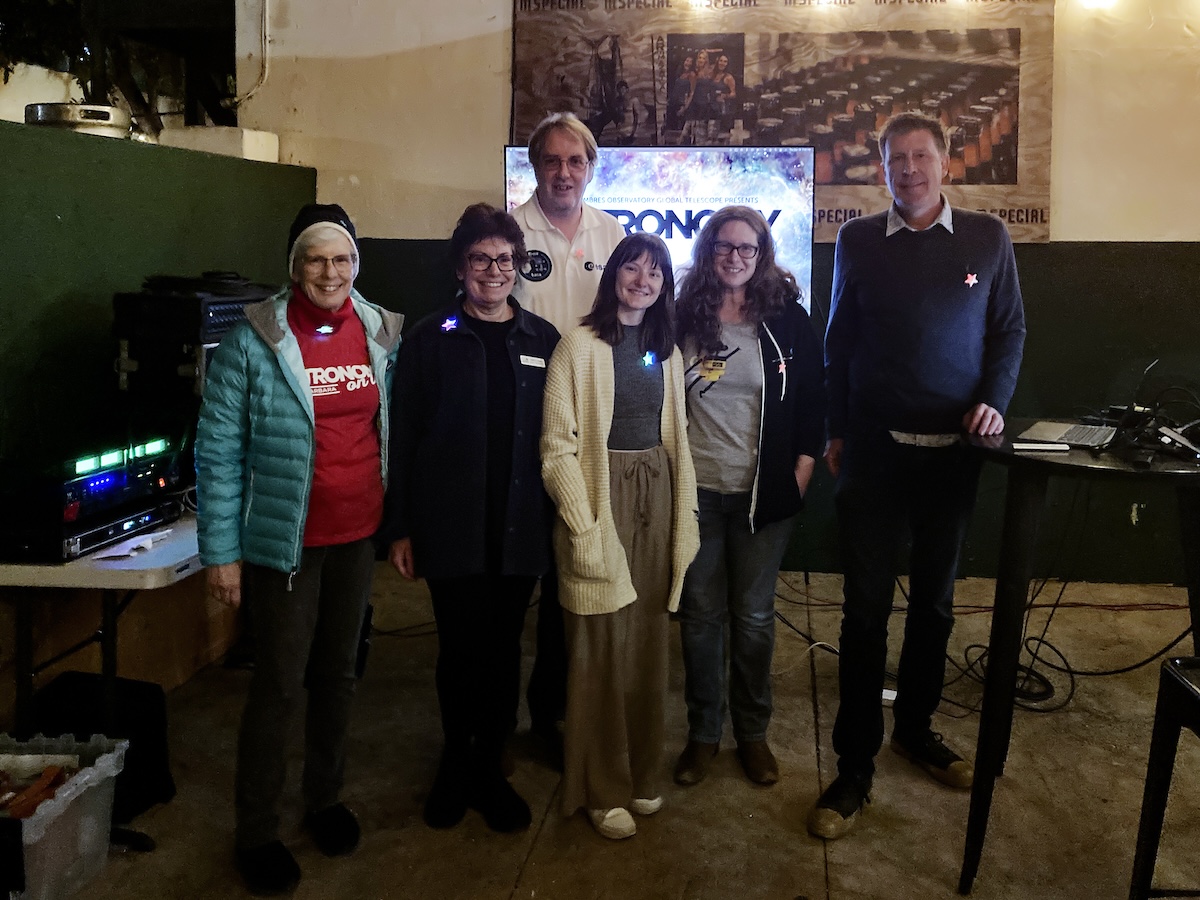HERA Mission, SpaceX & SciNews at November Astro on Tap

Captain’s Log Star Date 78338.4. It was the evening before the full Beaver moon for budding astrophysicists and stargazers from local universities to join with friends to hear the Las Cumbres Observatory’s renown astrophysicist Tim Lister PhD, with Andrew [Andy] Howell PhD and Moira Andrews UCSB grad student at the M Special pub. This free monthly info-sesh on space research with videos and convos with the scientists is just really cool. Donations are accepted via the pass around beer tip glass, merch sales and sponsorships. Swag included direct from the European Space Agency [ESA] – telescope stickers, HERA Mission patches and posters.
Lister started the program by explaining in semi-layman’s language his awarded work on NASA’s DART Mission, followed by his continued work with the ESA on their HERA Mission. Work he has been doing for 5 plus years. His cleverly titled talk –

“Hera-cule Poirot: Asteroid Crime Scene Investigator”, positioned his work as a crime scene investigator of asteroids incoming to Earth. He said, “We are working on preventing to us what happened to the dinosaurs at the Yucatán Peninsula 66 million years ago. There are approximately 2000 near Earth asteroids at 140 meters width, and numbers increasing at 100 more per year.” He cited Earth asteroid impacts at Chelyabinsk, Russia 2013, Tunguska, Siberia 1908, and the 50,000-year-old Arizona meteor crater.
Lister pointed out HERA was supposed to be paired with DART, to monitor its impact, take photos and assessments of the damages to the asteroid it impacted. Due to funding, HERA launched separately on 7 October 2024, to visit the asteroid Didymos and its moon Dimorphos as part of the NASA/ESA Asteroid Impact and Deflection Assessment (AIDA) collaboration. HERA launched via SpaceX’s Falcon 9 rocket from Kennedy Space Center, Florida, just two days prior to Hurricane Milton. DART proved we can successfully deflect an asteroid off course. HERA will size up the damages to the asteroid and study its full composition, take a few thousand images of all sides, take samples and more. HERA will fly by Mars in March 2025 to observe Mars and its moon. From there its full throttle to Didymos and Dimorphos.
HERA’s HyperScout H hyperspectral imager, that observes its targets across 25 spectral bands from the visible to near infrared 650–950 nm wavelength spectral range, colors beyond current human vision – is taking photos of everything on its journey…wait, Spock, 25 spectral bands? Yes, Captain Kirk, we have the info here.
Lister concluded with a QnA, and it was on to “Astronomy in the News” by Howell PhD and Andrews. Howell showed via video, the globally lauded recent SpaceX rocket booster, the 71m Super Heavy, re-entry to Earth captured on its launchpad via “chopsticks”, to which all attendees applauded. Although he was hard placed to not be impressed or appreciate Elon Musk’s SpaceX mission, [he is known for his outspoken dislike of SpaceX], he compensated by showing video of the rocket booster’s lower section on fire [which is was supposed to have by way of its back burn re-entry], and another video of SpaceX’s separate ocean landing of the Starship spacecraft on fire, set to house humans capping that these two fires were not in the news.
However, these were both reported, “The booster catch was not the only goal for Flight 5. SpaceX also aimed to send Starship’s 165-foot-tall (50 m) upper stage — known as Starship, or simply Ship — to space and bring it back to Earth with a splashdown in the Indian Ocean. That occurred about 65 minutes after liftoff, with the Ship firing three of its six engines to hover over the ocean before tipping over and exploding. Kate Tice, SpaceX manager of Quality Systems Engineering said, “That was amazing. We were not intending to recover any of Starship, so that was the best ending that we could have hoped for.” [ref: https://www.space.com/spacex-starship-flight-5-launch-super-heavy-booster-catch-success-video]
Howell talked about the International Space Station’s trash compactor; and Japan’s world’s first wooden satellite, LignoSat, launched into space on November 5, en route to the International Space Station on a SpaceX mission and later released into orbit about 400 km (250 miles) above the Earth. It was developed by Kyoto University and homebuilder Sumitomo Forestry.
Andrews talked about the discovery Earth’s second moon, in orbit from September – November 2024, aka “fly-by moon”, which is only viewable during our daylight hours; and NASA’s Europa Clipper spacecraft launch October 14, to study Jupiter’s moon Europa. It is expected to reach Jupiter and begin its close flybys of Europa by April 2030.







